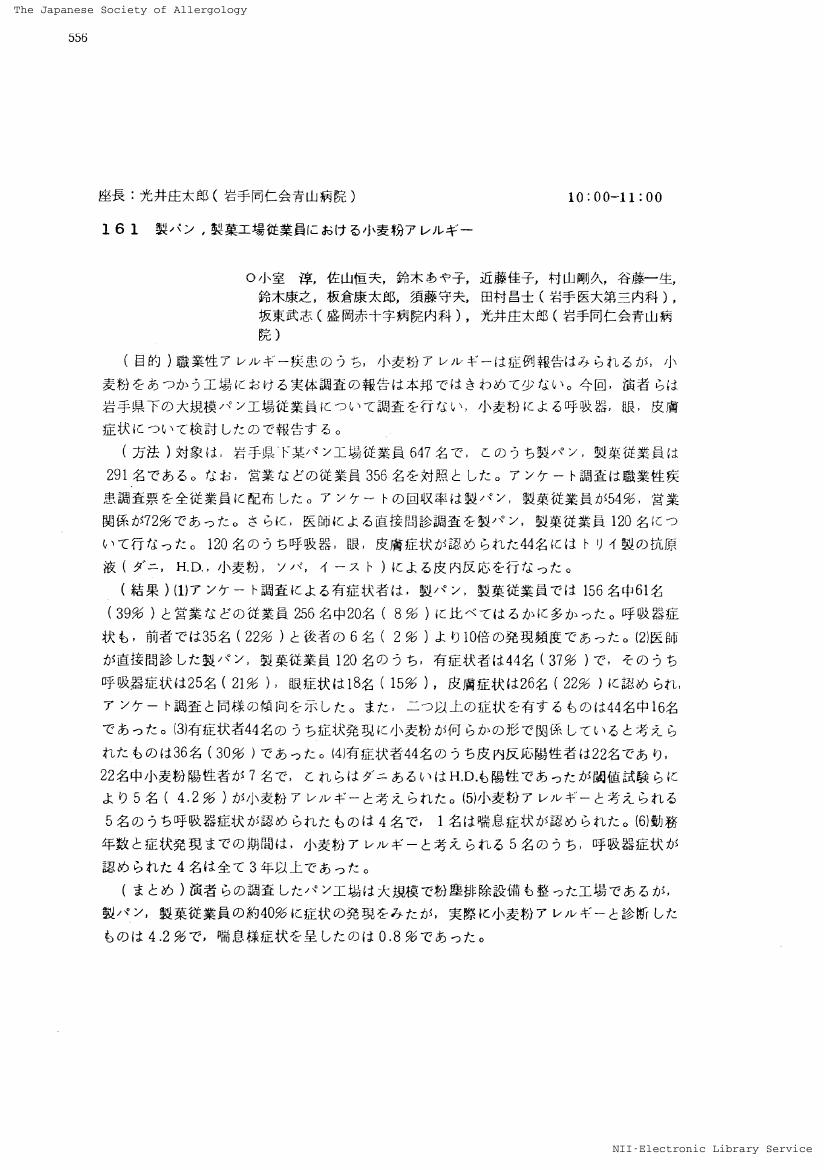2 0 0 0 OA 気管支喘息の病因
- 著者
- 光井 庄太郎 鹿内 喜佐男
- 出版者
- 一般社団法人 日本アレルギー学会
- 雑誌
- アレルギー (ISSN:00214884)
- 巻号頁・発行日
- vol.18, no.3, pp.198-212,241, 1969-03-30 (Released:2017-02-10)
According to the histories of the patients with bronchial asthma the factors involved in the occurrence of asthmatic attack were investigated and the following results were obtained. 1. Analysis of the season and occurrence of asthematic attack studied on 237 cases revealed that 55 had the attack in autumn, 52 regardless of the season, 31 in winter and 25 in both spring and autumn. 2. Of 685 asthmatics, the causes of the first asthmatic attack were presumed in 464 cases. They were common cold occurred in 245 cases, revealing the highest incidence, inhalation of sea-squirt substances in 80, pneumonia in 22, acute bronchitis in 17, fatigue in 14, cold and pregnancy in 11 each. Of 673 asthmatics, the causes or the inducing factors of asthmatic attack after the onset of bronchial asthma were presumed in 567 cases. They were related to: 1) physical conditions in 352 (common cold and influenza in 229, fatigue in 126, overeating in 34, psychic tension in 24, bathing in 19, etc.);. 2) weather in 222 (cold in 84, rainy day in 63, cloudy day in 33, sudden change in weather in 29, humid day in 21, etc.); 3) dust in 173 (sea-squirt substances in 83, house dust in 78, cotton wool in 9, etc.); 4) smoke and offensive odor in 91 (cigarette smoke in 38, smoke of mosquito stick and smoke of broiling fish in 9 each.) 5) food and drink in 79 (wine in 30, vegetable foods in 26, animal foods in 20, fatty foods in 9, etc.) ; 6) drugs in 9 (ACTH in 3, aspirin in 2, etc.) ; 7) animals in 6 (contact with domestic. animals in 4, furs and feathers in 2) ; 8) plants in 5 (newly-bult house in 3, pollen in 2); 9) molds in 5 (aspergillus in 2, other molds in 3). 3. The causes or the inducing factors of asthmatic attack above mentioned were studied as follows: l) those relating to the psychic and physical conditions were investigated from the view-point of the autonomic nervous function and the endocrine glands; 2) those relating to the infection of the upper respiratory tract were investigated from the view-point of bacterial allergy; 3) those relating to the inhalants and ingestants were investigated by the skin test with these substances; and the significant results were obtained from each of them. 4. The incidence rate of positive reaction in the intradermal test was 51.2% with house dust antigen, 41.8% with Paspat, 21.6% with ragweed pollen antigen, 15.5% with the mixed antigen of crab, lobster and oyster, 15.5% with sea-squirt antigen (except sea-squirt asthma patients), 11.8% with mixed antigen of cat hair and dog hair, 11.2% with yam antigen.
1 0 0 0 283 わが国の喘息死(続報)
- 著者
- 光井 庄太郎 石崎 達 小林 節雄
- 出版者
- 一般社団法人 日本アレルギー学会
- 雑誌
- アレルギー (ISSN:00214884)
- 巻号頁・発行日
- vol.36, no.8, 1987
1 0 0 0 133 わが国における喘息急死の統計的観察
- 著者
- 光井 庄太郎 石崎 達 小林 節雄
- 出版者
- 一般社団法人 日本アレルギー学会
- 雑誌
- アレルギー (ISSN:00214884)
- 巻号頁・発行日
- vol.34, no.8, 1985
1 0 0 0 第2回ヒスタグロビン研究会議事録
- 著者
- 堀内 淑彦 大藤 敏三 小川 栄太郎 大国 寿 川上 保雄 吉田 敏久 今井 耕一 大島 良雄 石崎 達 勝田 保男 唐戸 昭治 光井 庄太郎 高津 忠夫 春名 英彦 高島 広哉 進藤 宙二 山本 一哉 杉田 和春 山崎 昭 塩田 浩政 松山 秀介 高梨 雄蔵 細川 久昭 後藤 修二 柳田 則之 三河 春樹 安藤 格 滝野 義忠 西本 幸男 中島 武嗣 中本 明良 海田 智行 七条 小次郎 木村 利定 吉田 亮 吉田 全次 中島 重徳 飯塚 健郎
- 出版者
- 一般社団法人 日本アレルギー学会
- 雑誌
- アレルギー (ISSN:00214884)
- 巻号頁・発行日
- vol.16, no.2, pp.128-136, 1967
1 0 0 0 二重盲検法による気管支拡張剤ST1512の臨床試験
- 著者
- 五味 二郎 光井 庄太郎 工藤 康之 赤坂 喜三郎 小野 康夫 木村 武 川上 保雄 野口 英世 宮本 昭正 牧野 荘平 可部 順三郎 石崎 達 中島 重徳 熊谷 朗 野崎 忠信 富岡 玖夫 伊藤 和彦 斧田 太公望
- 出版者
- 一般社団法人 日本アレルギー学会
- 雑誌
- アレルギー (ISSN:00214884)
- 巻号頁・発行日
- vol.22, no.9, pp.599-612,614-61, 1973
気管支拡張剤ST1512(S群)の成人気管支喘息に対する薬効につき, metaproterenol(A群)およびinactive placebo(P群)を対照として, 頓用, 連用効果につき, 9施設による2重盲検試験を行った.open trialの結果から, Fisherの直接確率計算法により, 1群につき36例となり, 並列3群にあてはめれば3倍の108例前後の症例数でよいと考えられたため, 105例に達した時点で中間点検を行った.全例104例であり, S群34例, A群36例, P群34例で, 3群間にはback groundにおいて有意差はなかった.試験方法は, S群1錠(1mg), A群1錠(10mg), placebo1錠を投与し, 前および1時間後の自他覚症状, 肺機能を検した.医師の総合判定につき, H-test, U-testを行い, S群とP群間に危険率0.5%以下の高度の薬物差を認めたが, 危険率5%でS群とA群とP群間には有意差は検出されなかった.ついで薬効差につき, 詳細な3群判別分析を行い検討も行った.
